








Gail’s Dog Agility Page
The sport of dog agility
involves directing your dog through a course of 15-20 obstacles, including
jumps, tunnels, teeter-totter, a doggy balance beam, a six-foot high A-frame,
and weave poles. Like in horse show jumping, the fastest dog with a clean
round wins.
I’ve trained my three dogs in dog agility under the tutelage of
Jim Basic and Nancy Gyes at Power
Paws Agility, in San Jose, California. I’ve been competing since
1996, and am a member of The Bay Team
and the Salinas-Monterrey Agility
Racing Team (SMART) agility clubs.
Flint
Flint has been especially successful at agility. In 2000 he was the International Agility League Toy Dog of the Year. He came in second at the U. S. Dog Agility Association Nationals in 1999, third in 2000, and placed fourth at the AKC Nationals in 2001. He is the first 12"-jumping dog to have earned championships in the three major agility organizations.
Flint is a poster child for how dedicated training can improve distance work-having your dog respond to your commands to take obstacles at a distance. Flint went from a dog that would not move out of my shadow at high noon in the middle of the summer (as my distance-handling mentor Jim Basic likes to put it) to a dog that is one of the best distance-handling wee dogs in the country. He holds what we believe to be the record for consecutive Masters Gamblers Qs: 19!
At the age of 10, Flint still manages to make the USDAA Top Ten. He’s slower now, but sometimes our experience as a team makes up for our lack of youth and speed.
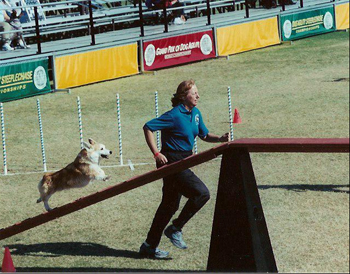
Gail and Flint competing in the semi-finals of the 2004
USDAA Nationals (photo by Ellen Finch).
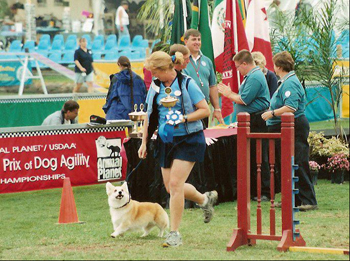
Flint watching Gail pick up their trophy at the 2003
USDAA Nationals (photo by Ellen Finch).
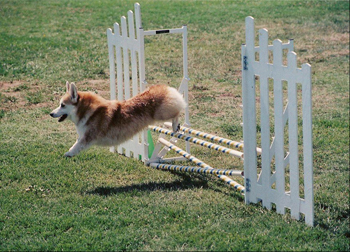
Flint nicely clearing a double jump
Maddy
I trained Maddy, now 12, as a lark, and as a way to complete her rehab
from surgery to repair a ruptured ACL. Never all that driven, except in
the presence of food, Maddy did complete a number of Excellent, Elite,
and PIII titles. She was a great crowd-pleaser as she sashayed through
the courses, her fluffy skirt flying. I retired her a number of years
ago because I didn’t want her doing the A-Frame given her shoulder
arthritis. Truth be told, she is just as happy to be retired to the role
of Daddy’s Little Girl.
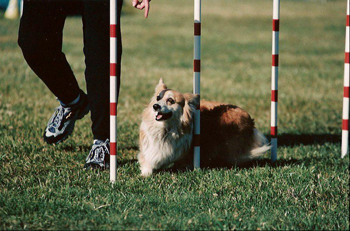
Maddy doing the weave poles in 1999
Pic
Pic at 4 years old is still a work in progress. He has great speed, is incredibly athletic, and is a fabulous jumper. He is not yet entirely convinced, however, that he needs to wait for me before he begins the course, or that he must stop on the contact obstacles. If someone tells you that male pyr sheps mature slowly, and it’s not worth training them until they are at least 3 years old, believe them!
To watch a movie of Gail and Pic doing a jumpers course, click here.
Pic's half-sister Luka won the 16" Steeplechase at the USDAA Nationals
in 2005 with her handler, Ashley Deacon, a physicist at the Stanford Linear
Accelerator. To see a movie clip of their blazing performance side-by-side
with the second-place team, Susan Garrett and her Jack Russell Terrier
Decaff, click here,
then scroll down to "Video Clips: Steeplechase Finals" under
"Friday Results".
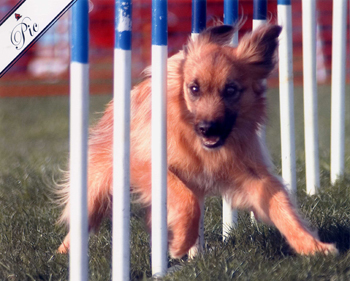 Pic single-stepping the weave poles like a border collie
(photo by Doghouse Arts).
Pic single-stepping the weave poles like a border collie
(photo by Doghouse Arts).

Pic riding the teeter totter down to the ground (photo
by Doghouse Arts).
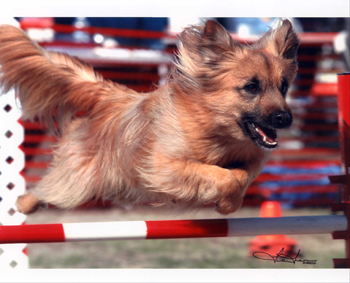 Pic
jumping with his usual enthusiasm (photo by Tien Tran Photography)
Pic
jumping with his usual enthusiasm (photo by Tien Tran Photography)
Interested in Training Your Own Dog?
All types of dogs can compete in dog agility, from Chihuahuas to Great Danes, including mixed breeds. Most trainers will require that your dog be at least a year old, and have basic doggy manners (recall, sit, stay, down) before you can join their classes. If you're interested in starting agility training with your own dog, you can find out about trainers in the S.F. Bay Area by consulting The Bay Team agility club site. The website also has links to many sites with additional information about dog agility. The Bay Team puts on several agility trials a year in the Bay Area. Spectators are welcome, as are their well-behaved children and dogs. No admission is charged, so it’s an inexpensive, fun outing to check out various types of dogs.
Teaching and Writing About Agility
I teach an advanced agility class each week at Diamond Bar Ranch in Woodside.
I’ve also written a few articles on dog agility for fun. (It seems
that even when I’m doing dog activities, I can’t stop being
a professor.)
Publications in my avocation: dog agility
Mahood, G. (2000) Flint and Maddy go to the USDAA Nationals. The Guardian,
Winter,
1999/2000: 6-7.
Mahood, G. (2000) Corgis in agility: jumping issues. Pembroke Welsh Corgi Newsletter. 35: 47-50.
Mahood, G. (2004) Finish what you start. Agility Ability. June issue: (on-line).
Mahood, G. (2004) Feeding your wee dog and thee. Agility Ability. July issue: (on-line).